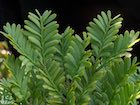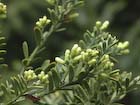Conservation Status

Pectinopitys ladei
(F.M. Bailey) C.N.Page 2019
Common names
Mount Spurgeon black pine or Mount Spurgeon brown pine.
Taxonomic notes
Type: Australia, Queensland, Mt. Spurgeon, Mitchell River, Port Douglas, F.W.H. Lade, foliage specimens December 1902, immature fruiting specimens May 1905 (syn BRI). Syn: Podocarpus ladei F.M. Bailey 1905 (Farjon 2010).
The molecular analysis by Sinclair et al. (2002) considered a subset of taxa from throughout the Podocarpaceae that included 6 species in Prumnopitys sensu latu, representing the genera Pectinopitys, Prumnopitys and Sundacarpus. The 3 species of Pectinopitys, including P. ladei, were in a group sister to a clade containing Prumnopitys and Sundacarpus; Little et al. (2013) obtained a very similar result in a later molecular study. This, along with many points of morphology, constitute Page's (2019) basis for assigning this species to Pectinopitys rather than Prumnopitys.
Description
Trees to 25 m tall. Bark smooth, red-brown, shed in thin scales. Leaves sessile, spirally arranged but secondarily distichous, oblong, 12-16×2.5-4 mm, obtuse, with stomata on both surfaces. Female cone a single scale subtending a seed, not expanding at maturity. Seeds ellipsoidal, to 25 mm long and 15 mm in diameter, purple-black when mature, pruinose (Hill 1998).
Distribution and Ecology
Australia: Queensland: Atherton Tableland. You can create a highly detailed map, and access specimen data, using the "search" function at the Australia Virtual Herbarium. Known only from remnant primary rainforest on Mt. Spurgeon and Mt. Lewis, where it grows in granite-derived soils at 930-1400 m elevation. The forest is dominated by angiosperms with scattered podocarps that include relatively more common Podocarpus smithii and Sundacarpus amarus (Farjon 2013). Based on data from 10 collection localities, its climate preferences include a mean annual temperature of 21°C, with an average minimum in the coldest month of 12°C, and a mean annual precipitation of 1620 mm (Biffin et al. 2011, Table S5). Zone 10 (cold hardiness limit between -1°C and +4.4°C) (Bannister and Neuner 2001).
The IUCN classifies this species as "Vulnerable" to human impacts due to its very limited extent of occurrence (161 km2) and association with primary rainforest. The estimated area of occupancy, based on known collection localities, is ca. 16 km2, and even within that area the tree is very rare and scattered, not in extended stands; the total population would not exceed 1,000 mature trees. Only 2 populations are known, in the vicinity of Mt. Lewis and Mt. Spurgeon. Logging formerly occurred in these areas, but habitat degradation has now ceased, and a large fraction of the remaining area of occurrence is within protected areas (Farjon 2013).
Remarkable Specimens
No data as of 2023.02.21.
Ethnobotany
The wood was formerly used for construction and carpentry, but logging has not been recorded since about 1980. It is not known in cultivation (Farjon 2013), but is present in some botanic gardens, as shown in the photos at right.
Observations
Mt. Lewis and Mt. Spurgeon. To find out precisely where would require exploring the collection records at GBIF (accessed 2023.02.26).
Remarks
The epithet honors a ranger in the Forestry Department, F. W. D. Lade, who collected the type specimens in 1902 and 1905 (Grant 2023).
Citations
Bailey, F. Manson. 1905. Contributions to the flora of Queensland. Queensland Agric. J. 15(8):899, t.22. Available: HathiTrust, accessed 2023.02.26.
Farjon, A. 2013. Prumnopitys ladei. The IUCN Red List of Threatened Species 2013: e.T34107A2846173. https://dx.doi.org/10.2305/IUCN.UK.2013-1.RLTS.T34107A2846173.en, accessed 2023.02.26.
Grant, Simon. 2023. Tree Treats--the Bunya Pine, Araucaria Bidwillii. International Dendrology Society Bits ‘n Bytes Botanical, August 2023, no pagination.
Little, Damon P., Patrick Knopf, and Christian Schulz. 2013. DNA barcode identification of Podocarpaceae—The second largest conifer family. PLoS ONE 8(11):e81008. https://doi.org/10.1371/journal.pone.0081008.
Page, Christopher N. 2019. New and maintained genera in the taxonomic alliance of Prumnopitys s.l. (Podocarpaceae), and circumscription of a new genus: Pectinopitys. New Zealand Journal of Botany 57(3):137–53. https://doi.org/10.1080/0028825X.2019.1625933.
Sinclair, W. T., R. R. Mill, M. F. Gardner, P. Woltz, Tanguy Jaffré, J. Preston, M. L. Hollingsworth, A. Ponge, and M. Möller. 2002. Evolutionary relationships of the New Caledonian heterotrophic conifer, Parasitaxus usta (Podocarpaceae), inferred from chloroplast TrnL-F intron/spacer and nuclear RDNA ITS2 sequences. Plant Systematics and Evolution 233(1–2):79–104.
See also
Observations on iNaturalist (accessed 2023.02.26).
The species account at Threatened Conifers of the World (accessed 2023.02.26).




